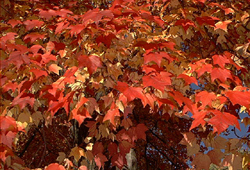- HubPages»
- Travel and Places»
- Visiting North America»
- United States
Fall Color Leaf Guide for the North Carolina Mountains

Why Leaves Change Color
North Carolina has over 120 species of trees, most of which are presented in the mountains. These trees provide brilliant colors each fall season. Different color pigments are present in all leaves: xanthophylls and carotenoids (yellow), anthocyanins (red), and chlorophyll (green). The yellow and red colors are usually hidden by the darker green color during the spring and summer months. But after the summer solstice in June, the trees are alerted that the days are getting shorter. This curtails the ability of the leaves to need and use sunlight and chlorophyll. As the covering of chlorophyll is reduced, the other pigments can eventually show themselves. This conglomeration of reds, yellows and greens give the leaves their purple, brown, and orange hues.
NC Mountain Ranges
North Carolina has three primary mountain ranges - the Appalachian, the Blue Ridge and the Great Smoky Mountains. These mountains have over 40 peaks with an elevation over 6,000 feet and 80 peaks between 5,000 and 6,000 feet. Five distinct forest types are represented: Pine-Oak, Cove Hardwood, Northern Hardwood, Spruce-Fir, and Hemlock. The varied elevations allow for a large selection of trees to thrive. Since North Carolina's mountains have a variety of tree species, there is usually a gradual and staggered changing in the leaves, which provides an extended color season.
Below are some of the tress that are most prevelant in the fall color display:
American Beech: Occurs at all elevations. The tree is easy to identify in winter due to its tendency to hang on to its dried leaves instead of immediately dropping them in the fall. Oak trees, which are in the same family, also retain their leaves.
Blackgum: Common in the lower and middle elevations. Its fall foliage is highlighted by an eye-catching blood-red hue that can be spotted from great distances.
Sugar Maple: Prevalent in rich soils at the lower and middle elevations. In fall, the bright red, yellow, and orange hues of this species can both outdo and unify the colors produced by other trees. The Sugarlands Visitor Center on the Tennessee side of the Great Smoky Mountains National Park was named for the large sugar maples that grew in the vicinity many years ago. These trees and others throughout the southern mountains were tapped for their sweet sap in late winter. One tree could produce 20 gallons of sap per year, which is enough to make a half-gallon or more of maple syrup.
Red Maple: Prominent in the lower and middle elevations and common up to 6,000 feet. Red and sugar maples can be distinguished by their leaves. Red maple leaves have V-shaped notches and the edges have coarse teeth. Sugar maple leaves have U-shaped notches and smooth edges.
Sweetgum: Most common beside of streams and in the moist areas of the lower elevations. The star-shaped leaves of this species are usually about the last to display their fall colors, which often range from purple to red to yellow on the same tree.
Sourwood: Abundant in the lower to middle elevations. The flowery tassels decorate the mountainsides from late June through July. During this period they attract bees that produce the honey named for this tree.
Tulip Poplar: This is one of the most abundant trees at elevations under 4,000 feet. The yellow leaf colors of this tree can cover entire mountain slopes in the autumn.
Flowering Dogwood: Found very frequently below 3,000 feet. The fall leaf colors usually range from red to maroon, but yellow pigments can also be seen.
Black Cherry: This large forest tree is fairly common up to about 5,300 feet. Leaf colors range from yellow to red.
Sassafras: Especially common in areas that have been disturbed, such as old fields, in the lower and middle elevations. The leaves are usually crimson or yellow.
Slippery Elm: Occurs mostly in the lower elevations. Along with winged elm and American elm, it is one of the elm species found in the southern mountains. The leaves are usually pale yellow in color.
Chestnut Oak: Most common in the rocky land of the lower and middle elevations. Stands of the trees are sometimes found on dry ridges. Leaves are usually yellow, but are sometimes red before turning brown.
Scarlet Oak: One of about 12 oak species found in the region. It is most common below 3,500 feet. The glossy-red leaves of this species make it one of the most attractive oak species in autumn.








